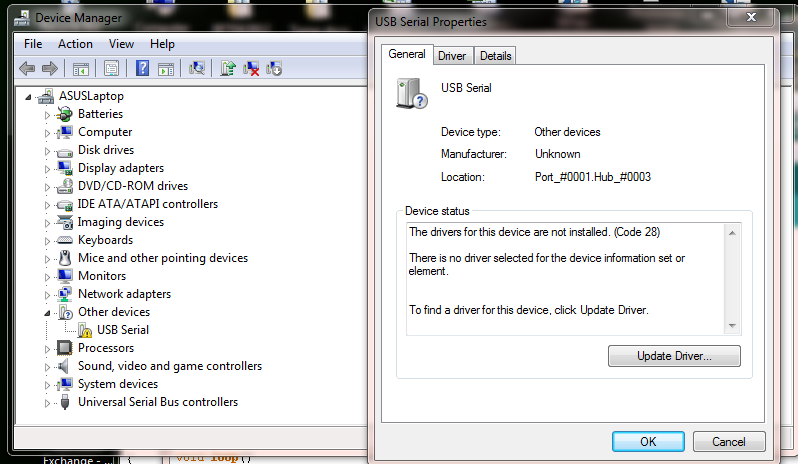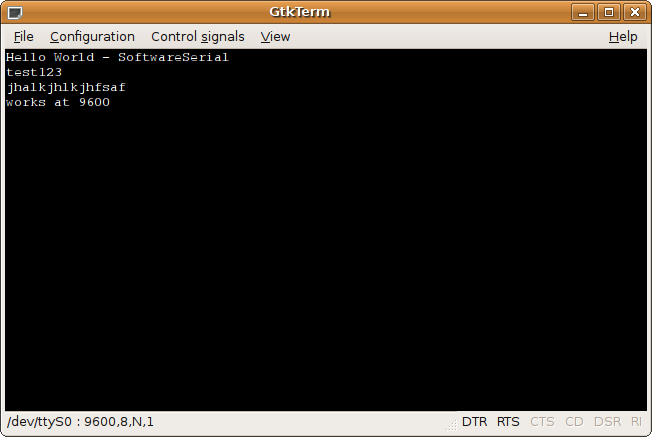

Can you mention where you purchased them? If you dont want to that's ok too, but thought it might be worthwhile knowing that too. You may have to send the boards back if it turns out that they are really bad. I wish you all the luck, and hope you get this resolved. It might be best to test them one at a time too, so after you test one, unplug the board and plug the next one it.Īlso, use a known good USB cable for all the tests.Īnother thing i would ask is, do the two bad boards power up? Can you see LED's lit? Do they have the notorious 'Blink' program loaded in them (you'd see one LED blinking on and off)? This will tell you pretty much for sure if the boards are really bad or just dont work with your computer's port controller for some reason. Look for an added port when you plug it in, or the name of the board in Device Manager.
ARDUINO SERIAL PORT NOT FOUND INSTALL
You dont have to install the IDE, just look in Device Manager as suggested elsewhere.

There is also the possibility that the USB controller on the Arduino board needs reflashing, but you'd have to check the Arduino site for information on that, and even if your boards have a chip that can be reflashed (with the firmware).Īll things considered so far, the best bet for you i would say is to try those three cards in another computer making sure to note which one works in your original computer and which two dont. The USB 3.0 ports may also appear to be 'upside down' as compared to the USB 2.0 ports. Note that most USB 3.0 ports have a blue colored plastic insert in the port jack, while USB 2.0 ports are usually red. It's hard to say for sure though, but obviously something is wrong and it's either the two boards or the two controller chips or the USB port. That would mean the other two boards would work if plugged into a USB 2.0 port.

There's one other possibility, and that is that the one 'good' board has a different USB controller chip than the other two (no matter where they came from) and those two controller chips dont work well with USB 3.0 and you are using USB 3.0 ports. Well, from what you have said so far (one is working and the other two are not working) then it sounds like, on the surface of it, that two of the boards are defective. It might also help to know where you purchased the board from. If you give more details about what you are using and what exactly you are experiencing, maybe someone here can help more. The only thiing i can think of here is to try the board in a computer with another operating system like maybe XP. This should not happen any more but i guess it is always a possibility.
ARDUINO SERIAL PORT NOT FOUND WINDOWS
If nothing ever helps with a given board it could be a bad board too, or a fake USB to RS232 converter chip on board that Windows has recognized as fake and shut it down. Sometimes hubs can work for some things but not other things until they are unplugged and plugged back in again. If using a USB hub, that may need to be unplugged and plugged back in again too, and even might need to reboot the computer to get it to work properly. If it is not working properly, then you will see something different and that will tell you right away that you have to unplug it and plug it back in for example

This helps troubleshoot because you'll see the listing change when you plug in the board, if it is working properly. You can go into Device Manager and see if your Arduino is listed there, or at least the COM 3 port. You can try closing down the IDE, then restarting it. You can try unplugging the board then plugging it back in. I ask about the port type because some of the Arduino's do not work in some USB 3.0 ports but work fine in USB 2.0 ports. I can offer a couple suggestions but would also have to ask a few questions too.įirst, does this happen with only one board or all your Arduino boards?Īlso, are you trying to use a USB 3.0 port or a USB 2.0 port?Īnother question, what kind of Ardu board are you using (Uno, etc.)?


 0 kommentar(er)
0 kommentar(er)
